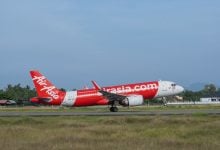Thai AirAsia boosts flights to visa-free Japan and China

In response to robust demand, Thai AirAsia is set to increase flights to coveted travel destinations like Japan and China, which offer visa-free access to visitors. The airline also plans to introduce a fresh route to Okinawa.
The initiative comes from Thai AirAsia’s chief executive, Santisuk Klongchaiya, who also helms SET-listed Asia Aviation (AAV). According to him, the surge in Thai travellers to these nations will result from their budget planning for foreign trips.
By the fourth quarter of 2023, Thai AirAsia was operating 77 flights weekly to 11 Chinese destinations. It also had seven weekly flights to Fukuoka in Japan.
Post the start of China’s visa-free scheme, a considerable boost in independent Thai tourists visiting the mainland is anticipated, according to Santisuk. The airline projects the share of Thai passengers per flight to increase from 10% to 30%, reported Bangkok Post.
Aside from Shanghai, which is currently served with five weekly flights, Thai AirAsia sees prospects for expanding flights to other key cities in China, says Santisuk.
During the Chinese New Year holidays, the airline experienced a 100% load factor on most flights connected with China, Hong Kong, and Taiwan, Santisuk added.
Santisuk noted that the visa exemption for China would not impact Japan’s demand, remaining a popular choice among Thai tourists. This preference is particularly strong among first-time international travellers.
To leverage the continuous demand for Japan, Thai AirAsia has plans to launch a new route from Don Mueang International Airport to Okinawa, starting from April 2 with four weekly flights. Santisuk expects the Okinawa route to achieve a load factor of at least 80-85%.
Around 90% of passengers are likely to be outbound from Thailand, Santisuk asserted.
Considering the strong demand for Japan, Thai AirAsia might enhance the number of flights to Fukuoka from daily to 10 per week this year, said Santisuk.
By the end of the year, the airline plans to acquire six new jets, including both Airbus 320 and 321neo. It aims to transport 21 million passengers this year with an average load factor of 88%, up from 18.8 million passengers in 2023.
Latest Thailand News
Follow The Thaiger on Google News:


























